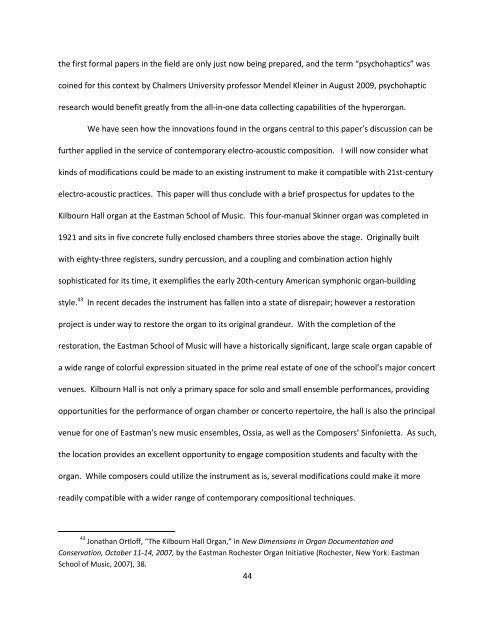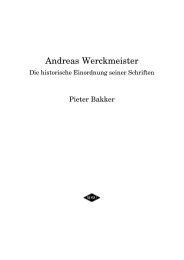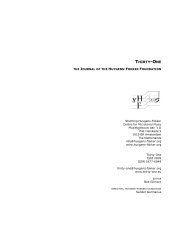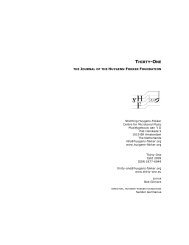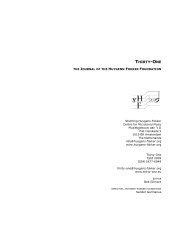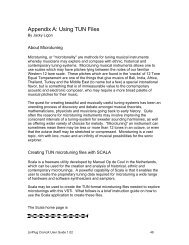Recent Organ Design Innovations and the 21st-century - Stichting ...
Recent Organ Design Innovations and the 21st-century - Stichting ...
Recent Organ Design Innovations and the 21st-century - Stichting ...
Create successful ePaper yourself
Turn your PDF publications into a flip-book with our unique Google optimized e-Paper software.
<strong>the</strong> first formal papers in <strong>the</strong> field are only just now being prepared, <strong>and</strong> <strong>the</strong> term “psychohaptics” was<br />
coined for this context by Chalmers University professor Mendel Kleiner in August 2009, psychohaptic<br />
research would benefit greatly from <strong>the</strong> all-in-one data collecting capabilities of <strong>the</strong> hyperorgan.<br />
We have seen how <strong>the</strong> innovations found in <strong>the</strong> organs central to this paper’s discussion can be<br />
fur<strong>the</strong>r applied in <strong>the</strong> service of contemporary electro-acoustic composition. I will now consider what<br />
kinds of modifications could be made to an existing instrument to make it compatible with <strong>21st</strong>-<strong>century</strong><br />
electro-acoustic practices. This paper will thus conclude with a brief prospectus for updates to <strong>the</strong><br />
Kilbourn Hall organ at <strong>the</strong> Eastman School of Music. This four-manual Skinner organ was completed in<br />
1921 <strong>and</strong> sits in five concrete fully enclosed chambers three stories above <strong>the</strong> stage. Originally built<br />
with eighty-three registers, sundry percussion, <strong>and</strong> a coupling <strong>and</strong> combination action highly<br />
sophisticated for its time, it exemplifies <strong>the</strong> early 20th-<strong>century</strong> American symphonic organ-building<br />
style. 43 In recent decades <strong>the</strong> instrument has fallen into a state of disrepair; however a restoration<br />
project is under way to restore <strong>the</strong> organ to its original gr<strong>and</strong>eur. With <strong>the</strong> completion of <strong>the</strong><br />
restoration, <strong>the</strong> Eastman School of Music will have a historically significant, large scale organ capable of<br />
a wide range of colorful expression situated in <strong>the</strong> prime real estate of one of <strong>the</strong> school’s major concert<br />
venues. Kilbourn Hall is not only a primary space for solo <strong>and</strong> small ensemble performances, providing<br />
opportunities for <strong>the</strong> performance of organ chamber or concerto repertoire, <strong>the</strong> hall is also <strong>the</strong> principal<br />
venue for one of Eastman’s new music ensembles, Ossia, as well as <strong>the</strong> Composers’ Sinfonietta. As such,<br />
<strong>the</strong> location provides an excellent opportunity to engage composition students <strong>and</strong> faculty with <strong>the</strong><br />
organ. While composers could utilize <strong>the</strong> instrument as is, several modifications could make it more<br />
readily compatible with a wider range of contemporary compositional techniques.<br />
43<br />
Jonathan Ortloff, “The Kilbourn Hall <strong>Organ</strong>,” in New Dimensions in <strong>Organ</strong> Documentation <strong>and</strong><br />
Conservation, October 11-14, 2007, by <strong>the</strong> Eastman Rochester <strong>Organ</strong> Initiative (Rochester, New York: Eastman<br />
School of Music, 2007), 38.<br />
44


